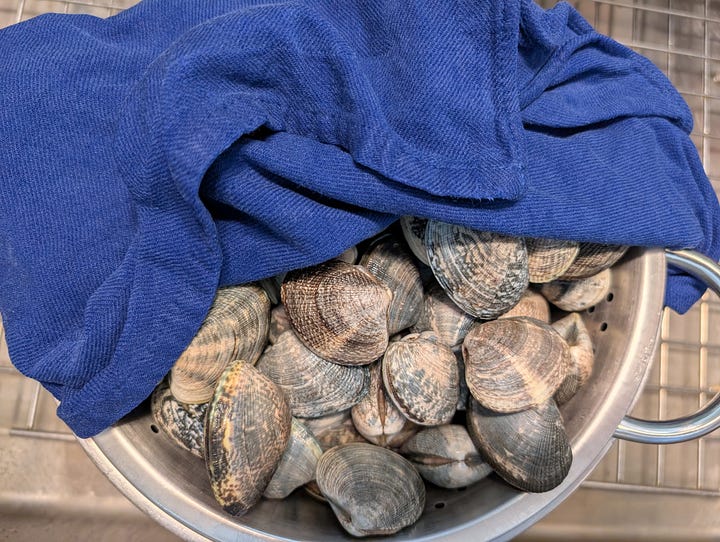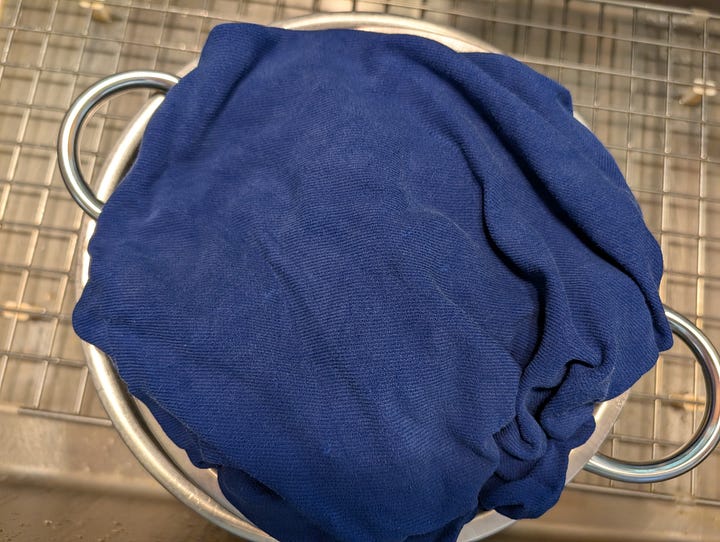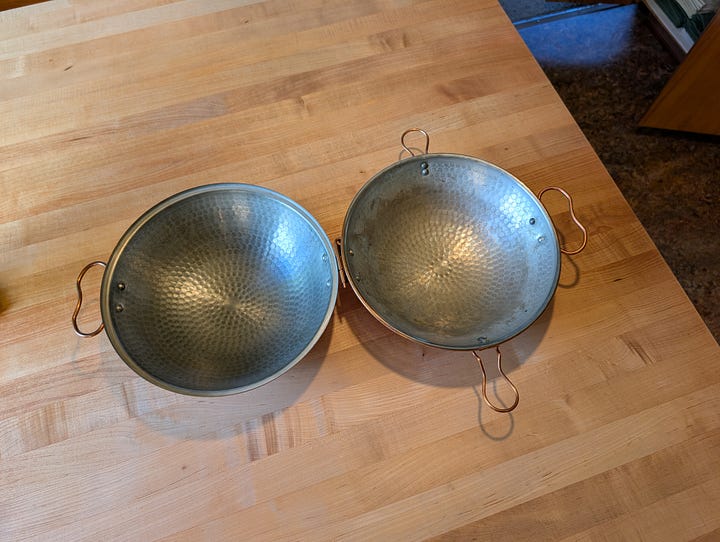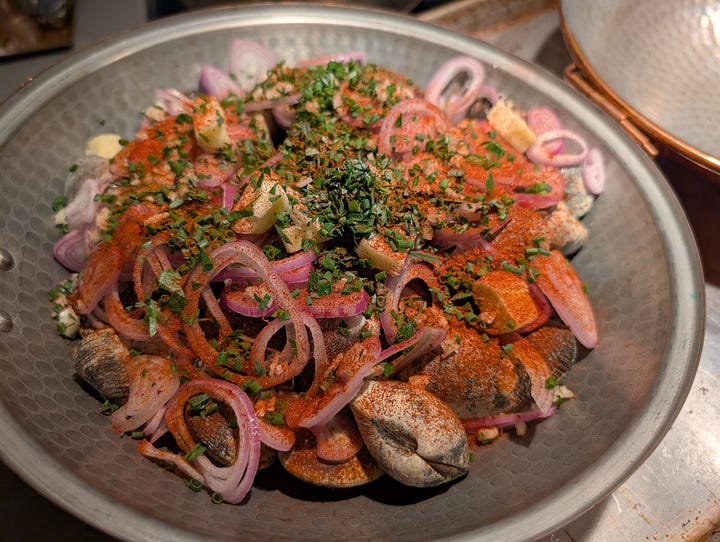Clams were of course among the seafoods covered in my latest cookbook, Shellfish, featured as the first of the book’s seven chapters—in part because I figured I might as well start with one of the most familiar and broadly loved of shellfish. They have, after all, been among the top ten seafoods consumed in the United States for a number of years. For all I know, much of that may be in the form of ever-popular clam chowder, which is also the first recipe I included in the book.
As techniques go, cooking clams is about as simple as cooking gets, requiring little more than fresh clams, a vessel, and some heat. One of my favorite examples of that simplicity encloses clams, a bit of butter, and a couple fresh bay leaves in a packet of heavy-duty foil to cook on a hot grill.
But simple technique doesn’t necessarily mean something’s easy to cook, if choosing or handling the ingredient is intimidating to begin with. I had a good reminder of that with a comment from someone who took a shellfish class I taught on Milk Street Kitchen a couple of years ago. Noting how much she enjoyed the class, the student said that until she heard me explain how to buy and store clams, she’d never felt comfortable cooking them.
And a friend who helped with recipe testing for my cookbook, including the clam chowder recipe, said she didn’t realize how easy it was to make clam chowder from scratch.
That’s what I love to hear! In my decades writing about seafood, I’ve always hoped to provide home cooks with delicious recipes and increased confidence buying and cooking seafood in general.
So today, it’s a focus on some buying and storing tips for clams.
Shopping for Clams
This is essentially the same advice I give for buying any fresh seafood: shop somewhere that shows you they care about their product. A pretty, tidy seafood case doesn’t necessarily mean better-quality seafood, but it’s generally a good indication of the attention they give to it. And a store that cares enough to sell great seafood likely has good turnover, so they’re regularly restocking the case, boding well for fresh selections.
In the case of live clams in the shell, it’s important they be on ice or otherwise well chilled, but not sitting in water (such as thaw from the ice).
It’s normal for clam shells to gape a bit as they sit, but they should close when jostled or tapped; widely gaping clams have likely expired and you shouldn’t buy them.
If you’re not going directly home with your clams, or it’s a long drive and/or a hot day, ask for some ice at the seafood counter to help keep the clams cold, or bring a small cooler with frozen gel packs from home.
Clams travel quite well, so keep in mind that mail order is another option. It’s a particularly great option for folks who have limited retail seafood options near them, but I occasionally order online too, even here in seafood-loving Seattle. As I did recently, ordering Manila clams from Hama Hama to cook the cataplana recipe below.


Storing Clams
Live clams need air and moisture to hold up until you cook them. When they’ve been wrapped in a bag and paper for transit, I unwrap them right after getting home, put the clams in a colander, and set that colander inside a large bowl for putting in the fridge. I top the clams with a well-dampened (but not dripping wet) kitchen towel so they don’t dry out. It’s unlikely that much water will accumulate in the bowl, but be sure the colander perches the clams a bit above the bottom of the bowl.
It’s always best to serve fresh seafood sooner than later, though clams should hold up well for a day or two. You’ll be reconfirming that they’re in good shape before cooking.
To Purge or Not to Purge?
I have cooked quite a lot of clams over the past decades and very rarely do I purge them. As I understand it, clams sold in stores have been purged before they get to us, something my clam-cooking experience has confirmed. Maybe there are some regional/species variances in that practice that I just don’t know about. You can always steam open a few clams in a batch that you’ve bought to see if they harbor any sand or grit. If you do detect some grit, you can put the remaining clams in a big bowl with cold water and refrigerate for 20 to 30 minutes (not longer). Drain well, scrub the clams, and continue with the preparation.
Before Cooking
Clean the clams just before cooking. In the colander, gently shake them under cold running water, to rinse the shells very well. I usually scrub the shells, too, especially when the clams are cooked in flavorful liquid in which they’ll be served (as opposed to steamed open to pluck out the cooked meat for another use).
Confirm that each clam’s shell is tightly closed, or closes when tapped on the counter or against another shell. You should discard, before cooking, any clams whose shells don’t tightly close. And discard any with broken or cracked shells. As you’re going through the clams, you might also come across one that is a clam-free shell full of sand or mud instead—as was the case with one clam in the batch I got recently. A good trick is to try sliding the two halves of the clam shell in opposite directions: a live clam will hold on tight and not let the halves slip; the shells should slide if no clam’s inside.
Cataplana Clams
This is inspired by the recipe for Brasa restaurant’s Cataplana Mussels that was in the 2001 Best Places Seattle Cookbook that I worked on with my great friend Kathy Casey. I recall that Brasa’s chef and owner Tamara Murphy had also served clams cooked in a cataplana at that beloved, celebrated restaurant of hers, which opened in 1999 and closed in 2010. It was a joy to honor Tamara by pulling out this recipe and sharing it for dinner with friends who also knew and loved her; she sadly passed away last August, gone far too soon.


This beautiful copper cataplana pan has been tucked away on a lower shelf in my kitchen for many years, I’m quite sure it dates to when I was testing recipes for that cookbook. I hope to get more use out of it now that I’ve dusted it off! The two rounded halves of the pan snap closed to hold in steam while cooking, done either in a very hot oven (which I did) or on stovetop. Once cooked, the lid of the opened pan can then double as a receptacle for the empty shells as you work your way through the clams. If that’s awkward for your table setting, you can instead scoop the clams and delicious accoutrements into bowls for serving.
If you don’t have a cataplana plan, which I trust may be most of you, I feel confident that this combination of ingredients would work well cooked in a large pot with a lid on the stovetop, as you would for steaming clams.
My cataplana pan is about 10 inches across and accommodated about three pounds of clams, which served as a light main course for four of us. We had already nibbled our way through smoked mussels, Portuguese sardines, Manchego, olives, and almonds. That’s always my favorite way to start an evening: quality snacking!! Alongside the clams, I served chickpeas I’d cooked with lemon and smoked paprika, and a salad of lettuce, watercress, and thinly shaved fennel.


2 to 3 pounds Manila or other small hardshell clams, shells scrubbed
3 shallots, thinly sliced
Juice of 2 lemons
1/4 cup dry white wine
2 tablespoons unsalted butter, cut into pieces
1 tablespoon minced tarragon
1 tablespoon minced flat-leaf parsley
1 tablespoon chopped chives
1 teaspoon minced garlic
1/2 teaspoon smoked paprika
Preheat the oven to 500°F
Go through the clams to make sure all the shells are firmly closed, discarding any that don’t close when tapped or that have broken or cracked shells.
Put the clams in the bottom portion of the cataplana pan. Scatter the shallots over, then drizzle the lemon juice and wine over the clams. Add the butter, herbs, garlic, and smoked paprika, sprinkling them evenly over. Gently toss the ingredients and clip the lid closed.
Bake the cataplana for 12 minutes. Take the pan from the oven, carefully unclip the lid, avoiding the steam that will escape. If all the clams have not opened, stir them gently, reclip the lid and return the pan to the oven to cook for a few minutes longer. Discard any clams that haven’t opened in this time.
Scoop the clams, shallots, and cooking liquids into individual bowls and serve right away. Or, carefully set the pan on a thick heatproof pad for serving at the table.
Makes 2 to 4 servings




I have habitually steamed my clams to get that intense liquor, but I’ll have to give this oven roast a try